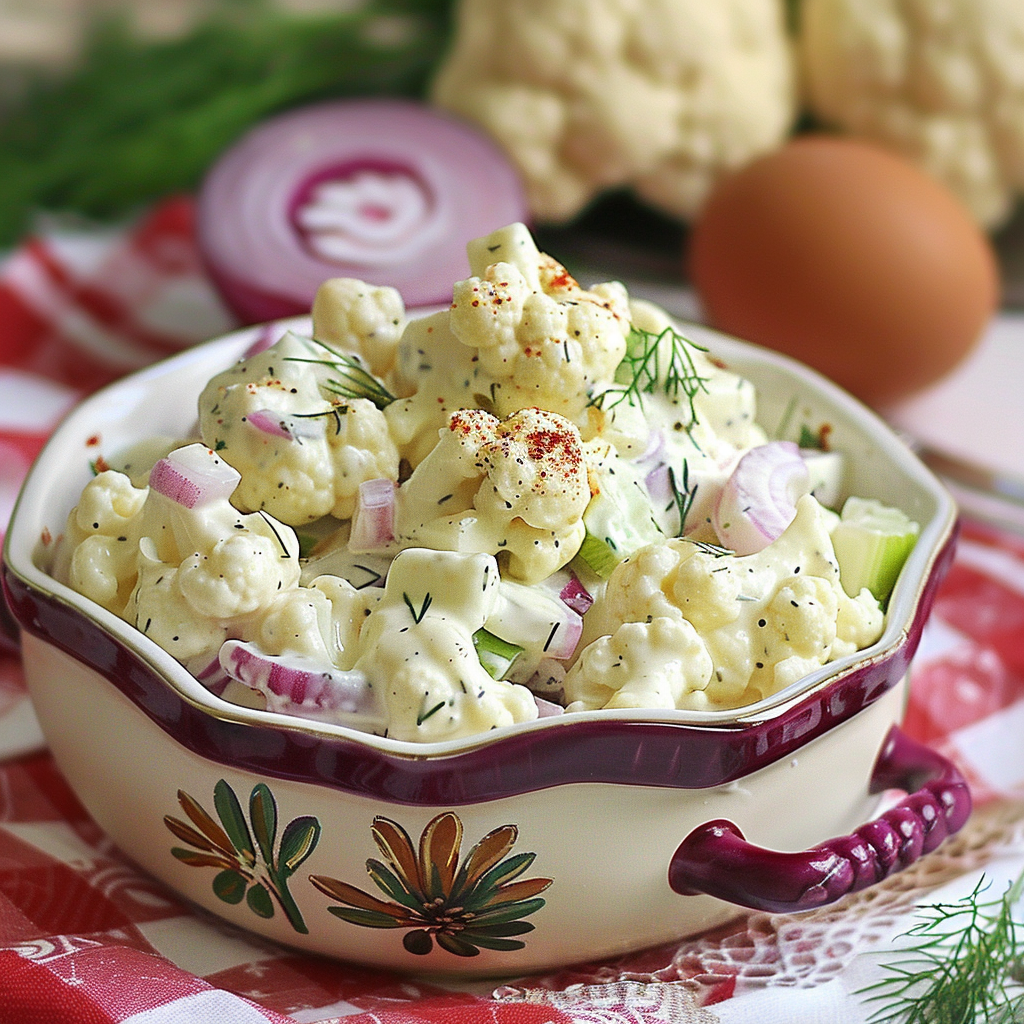Low-Carb Cauliflower Potato Salad Recipe

Share
My Refreshing Cauliflower Potato Salad Recipe
One summer afternoon, I decided to shake things up at our family barbecue by bringing a twist on the classic potato salad—Cauliflower Potato Salad. As someone who loves experimenting with lighter, healthier alternatives, I knew this dish would be a hit. The idea of using cauliflower instead of potatoes came to me as I was looking for a way to keep the creamy, comforting feel of potato salad without the heaviness. I remember the look of curiosity on everyone’s faces as they took their first bite, and then the smiles of approval that followed. The cauliflower mimics the texture of potatoes so well that most people didn’t even realize they were eating something different. It’s always fun to watch a dish come together, but what made this salad special was the way it elevated a simple side into something refreshing and unique, with all the creaminess and crunch we love—just a little lighter on the carbs. Every time I make it, I’m reminded that healthy swaps don’t have to sacrifice flavor or satisfaction.
Did You Know?
Cauliflower is a nutritional powerhouse, low in calories and high in important vitamins and minerals. A single serving of cauliflower provides a significant amount of vitamin C, which boosts the immune system, as well as vitamin K, which supports bone health. It’s also a great source of fiber, aiding in digestion and helping you feel full longer. Additionally, cauliflower contains antioxidants that protect against inflammation and may reduce the risk of chronic diseases.
Yield: 1 Serving
Ingredients:
4 cups cauliflower florets, steamed and cooled
4 hard-boiled eggs, chopped
1/2 cup diced red onion
1/2 cup diced celery
1/4 cup diced pickles
1/2 cup mayonnaise (preferably low-fat or avocado-based)
1/4 cup plain Greek yogurt
4 teaspoons Dijon mustard
2 tablespoons apple cider vinegar
1 teaspoon garlic powder
1 teaspoon onion powder
Salt and pepper to taste
4 teaspoons fresh dill, chopped
Paprika for garnish
Instructions:
Prepare the Dressing: In a bowl, mix the mayonnaise, Greek yogurt, Dijon mustard, apple cider vinegar, garlic powder, onion powder, salt, and pepper.
Personal Tip: Using Greek yogurt in the dressing not only lightens it up but also adds a subtle tang that pairs beautifully with the cauliflower.
Combine Ingredients: Add the steamed cauliflower, chopped eggs, red onion, celery, and pickles. Gently toss to coat.
Personal Tip: Make sure the cauliflower is fully cooled before adding it to the salad to prevent the dressing from becoming too watery.
Add Fresh Herbs: Fold in the chopped dill.
Personal Tip: Fresh dill adds a bright, herbaceous flavor that complements the other ingredients perfectly. Feel free to add more if you’re a dill lover!
Chill and Serve: Refrigerate for at least 1 hour. Garnish with paprika before serving.
Personal Tip: Chilling the salad allows the flavors to meld together, making each bite even more delicious.
Nutritional Information (Per Serving): Calories, 170 | Protein, 8g | Carbohydrates, 6g | Fiber, 2g | Net Carbohydrates, 4g | Fat, 14g | Saturated Fat, 3g | Cholesterol, 170mg | Sodium, 320mg | Sugars, 2g | Glycemic Index, Low
Kitchen Tips, Great Ideas, How to Save Money
- Steam Instead of Boil: Steaming cauliflower instead of boiling helps retain nutrients and prevents it from becoming overly soft, maintaining its texture in salads and side dishes.
- Use Greek Yogurt Substitutes: Substitute traditional mayonnaise with low-fat or avocado-based options, or use plain Greek yogurt for added creaminess with fewer calories and fat.
- Fresh Herb Enhancements: Incorporate fresh herbs like dill, parsley, or cilantro to add vibrant flavors without extra calories or sodium.
- Bulk Buying: Purchase cauliflower in bulk when it's in season or on sale, then steam and freeze extra portions for future use in salads or as a side dish.
- Versatile Substitutions: Experiment with different vegetables or add-ins like diced bell peppers, olives, or cherry tomatoes to customize the salad to your taste preferences.
- DIY Dressing: Make your own dressing with simple ingredients like Dijon mustard, apple cider vinegar, and spices to control flavor and avoid added sugars and preservatives.
- Portion Control: Prepare individual servings of Cauliflower Potato Salad in advance for quick, portion-controlled meals that support healthy eating habits.
- Meal Prep Friendly: Prepare a larger batch of Cauliflower Potato Salad to enjoy throughout the week, saving time and ensuring nutritious meals are readily available.
- Grow Your Own Herbs: Cultivate fresh herbs like dill in small pots or a garden to have on hand for adding flavor to various dishes, reducing grocery costs and waste.
- Budget-Friendly Ingredients: Opt for budget-friendly alternatives like frozen cauliflower florets or store-brand ingredients without sacrificing taste or quality.
Let’s Learn More About Different Cauliflowers and Where They Come From
Cauliflower isn’t just the white, crunchy vegetable we’re all familiar with—it actually comes in a variety of colors, each with its own unique flavor profile and nutritional benefits. For example, orange cauliflower, also known as “cheddar” cauliflower, has a sweeter, milder taste and is high in beta-carotene, which is good for your skin and eyes. Purple cauliflower gets its color from anthocyanins, the same antioxidants found in red cabbage and red wine, which may help reduce inflammation. Green cauliflower, sometimes called “broccoflower,” is a hybrid of broccoli and cauliflower and has a slightly sweeter flavor. The different types of cauliflower originate from various regions around the world, with many of the colorful varieties being cultivated in Europe and Asia. These vibrant cauliflowers not only add a pop of color to your plate but also offer different flavors and health benefits, making them a fun and nutritious addition to your meals.


